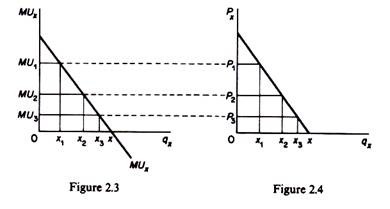Assumptions:
1. Rationality:
The consumer is rational. He aims at the maximization of his utility subject to the constraint imposed by his given income.
2. Cardinal Utility:
The utility of each commodity is measurable. Utility is a cardinal concept. The most convenient measure is money: the utility is measured by the monetary units that the consumer is prepared to pay for another unit of the commodity.
ADVERTISEMENTS:
3. Constant Marginal Utility of Money:
This assumption is necessary if the monetary unit is used as the measure of utility. The essential feature of a standard unit of measurement is that it be constant. If the marginal utility of money changes as income increases (or decreases) the measuring-rod for utility becomes like an elastic ruler, inappropriate for measurement.
4. Diminishing Marginal Utility:
The utility gained from successive units of a commodity diminishes. In other words, the marginal utility of a commodity diminishes as the consumer acquires larger quantities of it. This is the axiom of diminishing marginal utility.
ADVERTISEMENTS:
5. The total utility of a ‘basket of goods’ depends on the quantities of the individual commodities. If there are n commodities in the bundle with quantities x1, x2, . . . . , xn, the total utility is
U = f (x1, x2, …, xn)
In very early versions of the theory of consumer behaviour it was assumed that the total utility is additive,
U= U1(x1)+ U2(x2) + . . . + Un(xn)
ADVERTISEMENTS:
The additivity assumption was dropped in later versions of the cardinal utility theory. Additivity implies independent utilities of the various commodities in the bundle, an assumption clearly unrealistic, and unnecessary for the cardinal theory.
Equilibrium of the Consumer:
We begin with the simple model of a single commodity x. The consumer can either buy x or retain his money income Y. Under these conditions the consumer is in equilibrium when the marginal utility of x is equated to its market price (Px). Symbolically we have
MUX = Px
If the marginal utility of x is greater than its price, the consumer can increase his welfare by purchasing more units of x. Similarly if the marginal utility of x is less than its price the consumer can increase his total satisfaction by cutting down the quantity of x and keeping more of his income unspent. Therefore, he attains the maximization of his utility when MUX = Px.
If there are more commodities, the condition for the equilibrium of the consumer is the equality of the ratios of the marginal utilities of the individual commodities to their prices

Derivation of the Demand of the Consumer:
The derivation of demand is based on the axiom of diminishing marginal utility. The marginal utility of commodity x may be depicted by a line with a negative slope (figure 2.2). Geometrically the marginal utility of x is the slope of the total utility function U = f(qx). The total utility increases, but at a decreasing rate, up to quantity x, and then starts declining (figure 2.1).
Accordingly the marginal utility of x declines continuously, and becomes negative beyond quantity x. If the marginal utility is measured in monetary units the demand curve for x is identical to the positive segment of the marginal utility curve. At x1, the marginal utility is MU1 (figure 2.3). This is equal to P1, by definition. Hence at P1 the consumer demands x1 quantity (figure 2.4). Similarly at x2 the marginal utility is MU2, which is equal to P2. Hence at P2 the consumer will buy x2, and so on. The negative section of the MU curve does not form part of the demand curve, since negative quantities do not make sense in economics.
Critique of the Cardinal Approach:
There are three basic weaknesses in the cardinalist approach. The assumption of cardinal utility is extremely doubtful. The satisfaction derived from various commodities cannot be measured objectively. The attempt by Walras to use subjective units (utils) for the measurement of utility does not provide any satisfactory solution. The assumption of constant utility of money is also unrealistic.
As income increases the marginal utility of money changes. Thus money cannot be used as a measuring-rod since its own utility changes. Finally, the axiom of diminishing marginal utility has been ‘established’ from introspection, it is a psychological law which must be taken for granted.

